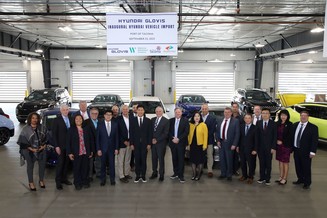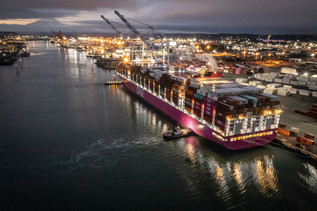|
At their Tuesday, October 4 meeting, The Northwest Seaport Alliance Managing Members will hear the Second Reading of the Terminal 10 Ray-Mont Logistics lease. If adopted, Terminal 10 will be utilized as a rail-dependent transloading facility for the export of agricultural products. Ray-Mont will initially utilize the site under the currently approved uses while concurrently seeking approval from permitting agencies to expand approved uses to include cargo moving equipment and vertical container stacking. Following approval, Ray-Mont will operate Terminal 10 as a containerized transloading terminal.
Additionally, Managing Members will hear the first reading of Resolution 2022-02 regarding Terminal 46. There are varying potential uses for the terminal that will be under consideration in the following months. The resolution aims to highlight principles that will provide policy guidance to NWSA staff on how to proceed with terminal use moving forward.
Managing Members will also receive a briefing on budget objectives as well as an update on current operations in the gateway.
View the full agenda.
The in-person special meeting begins at 11:00 a.m at Port of Seattle’s Conference Center. Meetings are also streamed live from the NWSA’s website.
To deliver comments by phone during the public comment portion of the meeting, please send an email to nwsacomment@nwseaportallianice.com by 9:00 a.m. Monday, Oct. 3, 2022 that includes your name, and the agenda topic you wish to speak to. Please include “speaker” in the subject line. Written comments may be submitted to the same email address.

In mid-September, the NWSA welcomed the inaugural delivery of Hyundai automobiles to the South Harbor in Tacoma. This new partnership between GLOVIS America, Wallenius Wilhelmsen Solutions (WWS) and NWSA will lead to a significant increase in both finished vehicles and breakbulk operations, and increased business to our local partners.
GLOVIS, created in 2002, undertook a competitive selection process to identify a single gateway as a point of entry for both Kia and Hyundai automobiles and to create capacity to grow with additional automotive customers. Streamlining the combined auto imports has proved advantageous in other geographic ports of call in the United States for GLOVIS America operations. NWSA’s South Harbor, which was already the port of entry for Kias processed by the Auto Warehousing Company (AWC), a long-term auto processor headquartered in Tacoma and a valued partner of the NWSA , was selected as having the ability and resources to handle the combined volume.
Read more here.
|
NWSA TEU volumes in August showed improvement vs. July with laden imports up 15% and laden exports up 19%.
Year-to-date volumes remain down compared to the same period of 2022. Vessel delays and omissions due to congestion in other ports continue to negatively impact volumes at the NWSA. Import volumes are also reflecting softening consumer demand for certain commodities.
Total container volume for the month decreased 10.4% with year-to-date volumes having declined 6.2% to 2,347,740 TEUs, with full imports and exports declining 10.4% and 21.8%, respectively.
Read more here.

The South harbor welcomed two brand-new ONE vessels to Husky Terminal for their maiden voyages to North America. The ONE Parana and ONE Magdalena are 12,000 TEU vessels built with cutting-edge technology to reduce impacts to the environment.
These two new vessels are part of four new ship builds for ONE with the naming convention based on rivers in Central/South America. These new vessels are replacing 9,000 TEU vessels and provide GHG emission reductions and more flexible container stowage.
|
|